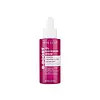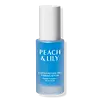What's inside
What's inside
 Key Ingredients
Key Ingredients

 Benefits
Benefits

 Ingredients Side-by-side
Ingredients Side-by-side

Water
Skin ConditioningNiacinamide
SmoothingMethylpropanediol
SolventGlycerin
HumectantPanthenol
Skin ConditioningTranexamic Acid
Astringent1,2-Hexanediol
Skin ConditioningHippophae Rhamnoides Extract
MaskingAscorbyl Glucoside
AntioxidantDipropylene Glycol
HumectantHydroxyacetophenone
AntioxidantGlutathione
Butylene Glycol
HumectantCaprylyl Glycol
EmollientCarbomer
Emulsion StabilisingArginine
MaskingTocopherol
AntioxidantGlycereth-26
HumectantDisodium EDTA
Betaine
HumectantPhellodendron Amurense Bark Extract
Skin ConditioningAstragalus Membranaceus Root Extract
EmollientScutellaria Baicalensis Root Extract
AstringentCoptis Chinensis Root Extract
AntioxidantBisabolol
MaskingDipotassium Glycyrrhizate
HumectantSodium Hyaluronate
HumectantEthylhexylglycerin
Skin ConditioningHexapeptide-9
Skin ConditioningPalmitoyl Pentapeptide-4
Skin ConditioningPalmitoyl Tripeptide-1
Skin ConditioningPalmitoyl Tetrapeptide-7
Skin ConditioningAcetyl Hexapeptide-8
HumectantNonapeptide-1
Skin ConditioningWater, Niacinamide, Methylpropanediol, Glycerin, Panthenol, Tranexamic Acid, 1,2-Hexanediol, Hippophae Rhamnoides Extract, Ascorbyl Glucoside, Dipropylene Glycol, Hydroxyacetophenone, Glutathione, Butylene Glycol, Caprylyl Glycol, Carbomer, Arginine, Tocopherol, Glycereth-26, Disodium EDTA, Betaine, Phellodendron Amurense Bark Extract, Astragalus Membranaceus Root Extract, Scutellaria Baicalensis Root Extract, Coptis Chinensis Root Extract, Bisabolol, Dipotassium Glycyrrhizate, Sodium Hyaluronate, Ethylhexylglycerin, Hexapeptide-9, Palmitoyl Pentapeptide-4, Palmitoyl Tripeptide-1, Palmitoyl Tetrapeptide-7, Acetyl Hexapeptide-8, Nonapeptide-1
Water
Skin ConditioningDipropylene Glycol
HumectantGlycerin
Humectant1,2-Hexanediol
Skin ConditioningBetaine
HumectantCopper Tripeptide-1
Skin ConditioningAcetyl Hexapeptide-8
HumectantPalmitoyl Tripeptide-1
Skin ConditioningTetrapeptide-21
Skin ConditioningTetrapeptide-30
Skin ConditioningHeptasodium Hexacarboxymethyl Dipeptide-12
Skin ConditioningAcetyl Tetrapeptide-5
HumectantPalmitoyl Tripeptide-38
Skin ConditioningPalmitoyl Pentapeptide-4
Skin ConditioningDipeptide-2
Skin ConditioningTripeptide-1
Skin ConditioningHexapeptide-9
Skin ConditioningNonapeptide-1
Skin ConditioningCollagen Extract
Skin ConditioningSerine
MaskingMethionine
Skin ConditioningCysteine
AntioxidantArginine
MaskingAcmella Oleracea Extract
Skin ProtectingAlpha-Glucan Oligosaccharide
CleansingSodium PCA
HumectantUlmus Davidiana Root Extract
Skin ConditioningCichorium Intybus Root Extract
MaskingHelianthus Tuberosus Root Extract
Skin ConditioningTremella Fuciformis Extract
HumectantFomes Officinalis Extract
Skin ProtectingLentinus Edodes Extract
Skin ConditioningPyrus Malus Fruit Extract
Skin ConditioningLens Esculenta Fruit Extract
Skin ConditioningCitrullus Lanatus Fruit Extract
Skin ConditioningSodium Acetylated Hyaluronate
HumectantHydrolyzed Hyaluronic Acid
HumectantHyaluronic Acid
HumectantSodium Hyaluronate
HumectantSodium Hyaluronate Crosspolymer
HumectantPotassium Hyaluronate
Skin ConditioningSqualane
EmollientFicus Carica Fruit Extract
HumectantCynanchum Atratum Extract
Skin ConditioningHydroxypropyltrimonium Hyaluronate
Ocimum Sanctum Leaf Extract
Skin ConditioningMelia Azadirachta Leaf Extract
Skin ConditioningCurcuma Longa Root Extract
MaskingCorallina Officinalis Extract
Skin ConditioningSolanum Melongena Fruit Extract
Skin ConditioningCoccinia Indica Fruit Extract
Skin ConditioningGellan Gum
Butylene Glycol
HumectantAdenosine
Skin ConditioningAloe Barbadensis Flower Extract
EmollientMelia Azadirachta Flower Extract
Skin ConditioningPolyglyceryl-10 Eicosanedioate/Tetradecanedioate
Skin ConditioningPolyquaternium-51
Skin ConditioningSodium Polyacryloyldimethyl Taurate
Emulsion StabilisingHydroxypropyl Cyclodextrin
MaskingEthylhexylglycerin
Skin ConditioningHydroxyethylcellulose
Emulsion StabilisingCaprylyl Glycol
EmollientWater, Dipropylene Glycol, Glycerin, 1,2-Hexanediol, Betaine, Copper Tripeptide-1, Acetyl Hexapeptide-8, Palmitoyl Tripeptide-1, Tetrapeptide-21, Tetrapeptide-30, Heptasodium Hexacarboxymethyl Dipeptide-12, Acetyl Tetrapeptide-5, Palmitoyl Tripeptide-38, Palmitoyl Pentapeptide-4, Dipeptide-2, Tripeptide-1, Hexapeptide-9, Nonapeptide-1, Collagen Extract, Serine, Methionine, Cysteine, Arginine, Acmella Oleracea Extract, Alpha-Glucan Oligosaccharide, Sodium PCA, Ulmus Davidiana Root Extract, Cichorium Intybus Root Extract, Helianthus Tuberosus Root Extract, Tremella Fuciformis Extract, Fomes Officinalis Extract, Lentinus Edodes Extract, Pyrus Malus Fruit Extract, Lens Esculenta Fruit Extract, Citrullus Lanatus Fruit Extract, Sodium Acetylated Hyaluronate, Hydrolyzed Hyaluronic Acid, Hyaluronic Acid, Sodium Hyaluronate, Sodium Hyaluronate Crosspolymer, Potassium Hyaluronate, Squalane, Ficus Carica Fruit Extract, Cynanchum Atratum Extract, Hydroxypropyltrimonium Hyaluronate, Ocimum Sanctum Leaf Extract, Melia Azadirachta Leaf Extract, Curcuma Longa Root Extract, Corallina Officinalis Extract, Solanum Melongena Fruit Extract, Coccinia Indica Fruit Extract, Gellan Gum, Butylene Glycol, Adenosine, Aloe Barbadensis Flower Extract, Melia Azadirachta Flower Extract, Polyglyceryl-10 Eicosanedioate/Tetradecanedioate, Polyquaternium-51, Sodium Polyacryloyldimethyl Taurate, Hydroxypropyl Cyclodextrin, Ethylhexylglycerin, Hydroxyethylcellulose, Caprylyl Glycol
 Reviews
Reviews

Ingredients Explained
These ingredients are found in both products.
Ingredients higher up in an ingredient list are typically present in a larger amount.
1,2-Hexanediol is a synthetic liquid and another multi-functional powerhouse.
It is a:
- Humectant, drawing moisture into the skin
- Emollient, helping to soften skin
- Solvent, dispersing and stabilizing formulas
- Preservative booster, enhancing the antimicrobial activity of other preservatives
Acetyl Hexapeptide-8, commonly known as Argireline or Acetyl Hexapeptide-3, is a popular peptide in skincare. It’s often referred to as a “Botox-like” ingredient because it helps reduce muscle movement.
By relaxing these micro-movements, Argireline may help minimize the appearance of fine lines and wrinkles. That said, it’s not as powerful as Botox, and research on its long-term effectiveness is still limited.
Beyond smoothing, Argireline may also support collagen production. Collagen is the protein that helps keep your skin firm, bouncy, and well-hydrated by strengthening the skin barrier.
So while Argireline isn’t a miracle fix, it can be a helpful addition to a routine focused on both prevention and skin health.
Read more about other common types of peptides here:
Learn more about Acetyl Hexapeptide-8Arginine is an amino acid that is important for human development. Your body uses is it to produce hair keratin and skin collagen.
As a cosmetic ingredient, Arginine has antioxidant properties and can also help repair damaged skin. This ingredient is derived either synthetically or from animals.
Arginine isn't fungal acne safe when used in the presence of other lipids (fats, fatty acids, oils, esters, etc). Oils and fats occur naturally within the skin, so take caution when using Arginine if you're prone to fungal acne.
Learn more about ArginineBetaine is a common humectant (a substance that promotes retention of moisture). It's known to be gentle on the skin and can help balance hydration.
This ingredient is best for improving hydration and soothing irritated skin. Studies also show it helps even out skin tone.
Fun fact: Betaine is naturally created in the skin and body. The kind found within cosmetic products can be either plant-derived or synthetic.
Another name for betaine is trimethylglycine.
Learn more about BetaineButylene Glycol (or BG) is used within cosmetic products for a few different reasons:
Overall, Butylene Glycol is a safe and well-rounded ingredient that works well with other ingredients.
Though this ingredient works well with most skin types, some people with sensitive skin may experience a reaction such as allergic rashes, closed comedones, or itchiness.
Learn more about Butylene GlycolCaprylyl Glycol is a humectant and emollient, meaning it attracts and preserves moisture.
It is a common ingredient in many products, especially those designed to hydrate skin. The primary benefits are retaining moisture, skin softening, and promoting a healthy skin barrier.
Though Caprylyl Glycol is an alcohol derived from fatty acids, it is not the kind that can dry out skin.
This ingredient is also used as a preservative to extend the life of products. It has slight antimicrobial properties.
Learn more about Caprylyl GlycolDipropylene Glycol is a synthetically created humectant, stabilizer, and solvent.
This ingredient helps:
Dipropylene glycol is technically an alcohol, but it belongs to the glycol family (often considered part of the ‘good’ alcohols). This means it is hydrating and gentle on skin unlike drying solvent alcohols like denatured alcohol.
As a masking agent, Dipropylene Glycol can be used to cover the smell of other ingredients. However, it does not have a scent.
Studies show Dipropylene Glycol is considered safe to use in skincare.
Learn more about Dipropylene GlycolEthylhexylglycerin (we can't pronounce this either) is commonly used as a preservative and skin softener. It is derived from glyceryl.
You might see Ethylhexylglycerin often paired with other preservatives such as phenoxyethanol. Ethylhexylglycerin has been found to increase the effectiveness of these other preservatives.
Glycerin is already naturally found in your skin. It helps moisturize and protect your skin.
A study from 2016 found glycerin to be more effective as a humectant than AHAs and hyaluronic acid.
As a humectant, it helps the skin stay hydrated by pulling moisture to your skin. The low molecular weight of glycerin allows it to pull moisture into the deeper layers of your skin.
Hydrated skin improves your skin barrier; Your skin barrier helps protect against irritants and bacteria.
Glycerin has also been found to have antimicrobial and antiviral properties. Due to these properties, glycerin is often used in wound and burn treatments.
In cosmetics, glycerin is usually derived from plants such as soybean or palm. However, it can also be sourced from animals, such as tallow or animal fat.
This ingredient is organic, colorless, odorless, and non-toxic.
Glycerin is the name for this ingredient in American English. British English uses Glycerol/Glycerine.
Learn more about GlycerinHexapeptide-9 is a peptide.
Nonapeptide-1 is created from amino acids including arginine and lysine.
It has antioxidant and antimicrobial properties.
Emerging studies show Nonapeptide-1 to help with reducing pigmentation and brightening the skin. It has shown to prevent the activation of tyrosinase, an enzyme in the skin that begins the process of melanin creation. Melanin is responsible for giving skin a tan or dark spots.
Learn more about Nonapeptide-1You might know this ingredients as Matrixyl, a famous peptide.
Peptides are building blocks for protein. Palmitoyl Pentapeptide-4 consists of five amino acids. These amino acids include: 2 lysines, 2 threonines, and serine
This ingredients tells our body to create more collagen. Collagen is a protein that makes connective tissue. Boosting collagen production leads to a healthier skin barrier. Having a healthy skin barrier means having firm and hydrated skin.
Thus, Matrixyl may help improve the look of wrinkles.
Read more about other common types of peptides here:
Learn more about Palmitoyl Pentapeptide-4Palmitoyl Tripeptide-1 is also known as pal-GHK. It is made up of 3 amino acids and palmitic acid, a fatty acid that helps it absorb into skin more easily.
This peptide is as a signal peptide, meaning it tells the skin to produce more collagen. Collagen is the key protein that helps form the skin's structure and keep it plump, firm, and hydrated.
By boosting collagen production, this ingredient supports a stronger skin barrier and helps reduce the appearance of wrinkles.
You'll most likely see this ingredient paired with Palmitoyl Tetrapeptide-7 in the well-known Matrixyl 3000 complex. While results from in-house testing should be viewed cautiously, this peptide duo is among the most studied and widely used in modern skincare.
Due to its palmitic acid base, this ingredient may not be safe for Malassezia folliculitis.
Read more about other common types of peptides here:
Learn more about Palmitoyl Tripeptide-1Sodium Hyaluronate is hyaluronic acid's salt form. It is commonly derived from the sodium salt of hyaluronic acid.
Like hyaluronic acid, it is great at holding water and acts as a humectant. This makes it a great skin hydrating ingredient.
Sodium Hyaluronate is naturally occurring in our bodies and is mostly found in eye fluid and joints.
These are some other common types of Hyaluronic Acid:
Learn more about Sodium HyaluronateWater. It's the most common cosmetic ingredient of all. You'll usually see it at the top of ingredient lists, meaning that it makes up the largest part of the product.
So why is it so popular? Water most often acts as a solvent - this means that it helps dissolve other ingredients into the formulation.
You'll also recognize water as that liquid we all need to stay alive. If you see this, drink a glass of water. Stay hydrated!
Learn more about Water